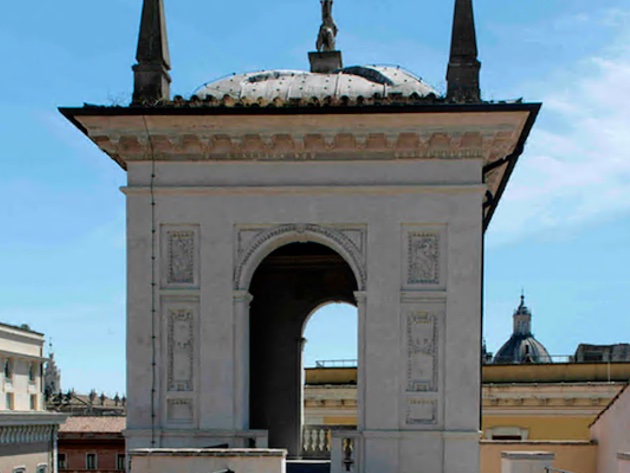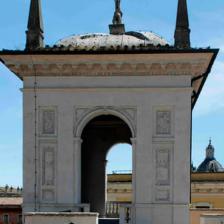
Yesterday, the restoration of the roof terrace of Palazzo Altemps was inaugurated, one of the most fascinating architectures of the late Roman Renaissance, built at the end of the sixteenth century by Martino Longhi the Elder and completed by Onorio Longhi. Located on the south-east corner of the palace, the roof terrace stands out for its size and for its decorative layout, which includes the ibex, the heraldic symbol of the Altemps family.
The intervention, carried out between November 2023 and September 2024, involved both the interior and exterior of the roof terrace, restoring all the beauty of the architecture and the decorated surfaces; furthermore, a new lighting system allows it to be viewed from below, enhancing its charm even in the evening hours.
With the restoration work on the interior decoration, until now hidden by heavy repainting, a clear sky of a very intense blue, with white and ochre clouds, crossed by birds, has come to light on the vault of the pavilion, and on the east, south and west walls a splendid architectural score with openings always on a fake sky. The north wall instead appears completely painted in blue and is delimited at the bottom by a fake marble skirting. Unfortunately, the three east, south and west walls have lost part of the painting and the supporting plaster. The intervention therefore saw the creation of a new plaster that approaches the surviving parts, with a grey tone close to the color of the underlying arriccio, in order to enhance the reading of the context.
During the works, it was also ascertained, through a careful campaign of diagnostic investigations, that the recovered paintings are attributable to a draft subsequent to that of the architectural construction of the roof terrace. The first draft in fact – late sixteenth century – appears underneath the recovered painting and consists of a monochrome tempera with a pink/cream background and green border.
The identification of the pigments used for the blue sky – artificial ultramarine blue and emerald green – and others for the creation of the birds has made it possible to contextualize the execution of the paintings in a time frame between 1830 and the early twentieth century, corresponding to the last phase of Palazzo Altemps.
The exterior has also been carefully restored. The plaster and stucco have been consolidated, the capitals rebuilt in continuity with those already redone in 2016, the string course has become visible again with its fake marble decorations. The travertine balustrade has also been cleaned and integrated where necessary. The attic adjacent to the entrance of the roof terrace has also been structurally reinforced, now transformed into a panoramic terrace and equipped with a new protective railing.
The surrounding areas have finally been redeveloped through the revision and redoing of the plaster, the application of a new paint in chromatic agreement with that of the rest of the building and the terrace floors have also been cleaned.
The restoration is part of the Urbs. From the city to the Roman countryside project, financed with 70 million euros with funds from the National Complementary Plan (PNC) to the PNRR. The activity saw the work of an internal working group at the Museum that involved the restoration officials Debora Papetti and Fabiana Cozzolino with Laura Ruggeri for the project and the management of the works, the archaeologist Chiara Giobbe for the activities aimed at promoting and enhancing the site and the architect Saveria Petillo for the supervision of the design and Technical Office.
Starting from July, every second and third weekend of the month, visitors can access the altana thanks to guided tours curated by Chiara Giobbe in collaboration with the Educational Service and conducted by the Museum staff.
Photo: Roof terrace of Palazzo Altemps, MNR Photographic Archive, photo by M.Alivernini, L.Zizi
 Condividi
Condividi












































